
- •A Country Across the Channel
- •I. Fill in the blanks with the correct words.
- •II. Complete the sentences with the best answer (a, b or c).
- •III. Are the statements true or false? Correct the false statements.
- •IV. Answer the questions.
- •V. Draw a sketch-map of the British Isles and mark in the following.
- •Britain-an Island, or a Peninsula?
- •I. Fill in the blanks with the correct words.
- •II Complete the sentences with the best answer (a, b or c).
- •III. Are the statements true or false? Correct the false statements.
- •IV. Answer the questions.
- •V. Do you remember?
- •The Face of Britain
- •II. Complete the sentences with the best answer (a, b or c).
- •III. Are the statements true or false? Correct the false statements.
- •IV. Answer the questions.
- •V. Draw a sketch map of the British Isles and include
- •Climate and Weather
- •I. Fill in the blanks with the correct words.
- •II. Complete the sentences with the best answer (a, b or c).
- •III. Are the statements true or false? Correct the false statements.
- •IV. Answer the questions.
- •Mineral Wealth
- •I. Fill in the blanks with the correct words.
- •II. Complete the sentences with the best answer (a, b or c).
- •III. Are the statements true or false? Correct the false statements.
- •IV. Answer the questions.
- •Who Are the British? (I) Ancient and Roman Britain
- •I. Fill in the blanks with the correct words.
- •II. Complete the sentences with the best answer (a, b or c).
- •III. Are the statements true or false? Correct the false statements.
- •IV. Answer the questions.
- •Who Are the British ? (II) t he Anglo-Saxons, Danes and Normans
- •I. Fill in the blanks with the correct words.
- •II. Complete the sentences with the best answer (a, b or c).
- •III. Are the statements true or false? Correct the false statements.
- •IV. Answer the questions.
- •Who Are the British? (Ill) The Irish
- •I. Fill in the blanks with the correct words.
- •II. Complete the sentences with the best answer (a, b or c).
- •III. Are the statements true or false? Correct the false statements.
- •IV. Answer the questions.
- •Stonehenge and Avebury
- •I. Fill in the blanks with the correct words.
- •III. Are the statements true or false? Correct the false statements.
- •IV. Answer the questions.
- •V. Explain the following
- •I. Fill in the blanks with the correct words.
- •II. Complete the sentences with the best answer (a, b or c).
- •III. Are the statements true or false? Correct the false statements.
- •IV. Answer the questions.
- •V. Do you remember?
- •Northern Ireland - the Land of the Giant's Causeway
- •I. Fill in the blanks with the correct words.
- •II. Complete the sentences with the best answer (a, b or c).
- •III. Are the statements true or false? Correct the false statements.
- •IV. Answer the Questions.
- •V. Explain:
- •Great Britain - a Constitutional Monarchy
- •I. Fill in the blanks with the correct words.
- •II. Complete the sentences with the best answer (a, bore).
- •III. Are the statements true or false? Correct the false statements.
- •IV. Answer the questions.
- •Mother of Parliaments
- •I. Fill in the blanks with the correct words.
- •II. Complete the sentences with the best answer (a, b or c).
- •III. Are the statements true or false? Correct the false statements.
- •IV. Answer the questions.
- •The Party System and the Government
- •I. Fill in the blanks with the correct words.
- •II. Complete the sentences with the best answer (a, b or c).
- •III. Are the statements true or false? Correct the false statements.
- •IV. Answer the questions.
- •The Press
- •I. Fill in the blanks with the correct words.
- •II. Complete the sentences with the best answer (a, b or c).
- •III Are the statements true or false? Correct the false statements.
- •IV. Answer the questions.
- •Radio and Television
- •I. Fill in the blanks with the correct words.
- •II. Complete the sentences with the best answer (a, b or c).
- •III. Are the statements true or false? Correct the false statements.
- •IV. Answer the questions.
- •The School Education
- •I. Fill in the blanks with the correct words.
- •II. Complete the sentences with the best answer (a, b or c).
- •III. Are the statements true or false? Correct the false statements.
- •IV. Answer the questions.
- •The Public Schools
- •I. Fill in the blanks with the correct words.
- •II. Complete the sentences with the best answer (a, b or c).
- •III. Are the statements true or false? Correct the false statements.
- •IV. Answer the questions.
- •The Economy. The South
- •I. Fill in the blanks with the correct words.
- •II. Complete the sentences with the best answer (a, b or c).
- •III. Are the statements true or false? Correct the false statements.
- •IV. Answer the questions.
- •The Regions of Britain
- •I. Fill in the blanks with the correct words.
- •III. Are the statements true or false? Correct the false statements.
- •IV. Answer the questions.
- •V. Do you remember?
- •Transport
- •I. Fill in the blanks with the correct words.
- •II. Complete the sentences with the best answer (a, b or c).
- •III. Are the statements true or false? Correct the false statements.
- •IV. Answer the questions.
- •Agriculture
- •I. Fill in the blanks with the correct words.
- •II. Complete the sentences with the best answer (a, b or c).
- •III. Are the statements true or false? Correct the false statements.
- •IV. Answer the questions.
- •Food and Meals
- •I. Fill in the blanks with the correct words.
- •III. Are the statements true or false? Correct the false statements.
- •IV. Answer the questions.
- •Some National Traits
- •I. Fill in the blanks with the correct words.
- •II. Complete the sentences with the best answer (a, b or c).
- •III. Are the statements true or false? Correct the false statements.
- •IV. Answer the questions.
- •The Church In Modern Life
- •II. Complete the sentences with the best answer (a, b or c).
- •III. Are the statements true or false? Correct the false statements.
- •IV. Answer the questions.
- •The British In Their Private Life
- •I. Fill in the blanks with the correct words.
- •III. Are the statements true or false? Correct the false statements.
- •IV. Answer the questions.
- •V. Do you remember?
- •English Gardens and Gardeners
- •I. Fill in the blanks with the correct words.
- •III. Are the statements true or false? Correct the false statements.
- •IV. Answer the questions.
- •Leisure and Sports
- •I. Fill in the blanks with the correct words.
- •III. Are the statements true or false? Correct the false statements.
- •IV. Answer the questions.
- •King Arthur
- •I. Fill in the blanks with the correct words.
- •II. Complete the sentences with the best answer (a, b or c).
- •III. Are the statements true or false? Correct the false statements.
- •IV. Answer the questions.
- •V. Do you remember?
- •"My Bonnie Lies Over the Ocean... "
- •I. Fill in the blanks with the correct words.
- •III. Are the statements true or false? Correct the false statements.
- •IV. Answer the questions.
- •Canterbury Cathedral and Geoffrey Chaucer - the Great English Story-Teller
- •I. Fill in the blanks with the correct words.
- •II. Complete the sentences with the best answer (a, b or c).
- •III. Are the statements true or false? Correct the false statements.
- •IV. Answer the questions.
- •Shakespeare and Shakespeareland
- •I. Fill in the blanks with the correct words.
- •III. Are the statements true or false? Correct the false statements.
- •IV. Answer the questions.
- •Britain's Great Hero
- •I. Fill in the blanks with the correct words.
- •II. Complete the sentences with the best answer (a, b or c).
- •III. Are the statements true or false? Correct the false statements.
- •IV. Answer the questions.
- •"The Lady With the Lamp"
- •I. Fill in the blanks with the correct words.
- •II. Complete the sentences with the best answer (a, b or c).
- •III. Are the statements true or false? Correct the false statements.
- •IV. Answer the questions.
- •Museums and Other Treasures
- •I. Fill in the blanks with the correct words.
- •II. Complete the sentences with the best answer (a, h or c).
- •III. Are the statements true or false? Correct the false statements.
- •IV. Answer the questions.
- •Chronological outline
- •Kings and queens of england from alfred
- •British prime ministers and governments
IV. Answer the questions.
1. Why is Florence Nightingale one of the most outstanding women in British history?
2. Who resembled Florence in Russia as regards reforming hospital service?
3. Where was Florence born?
4. Were her parents enthusiastic of her intention to become a nurse?
5. Was the nursing profession popular in Britain at that time?
6. In what did Florence resemble Yevfrosinniya of Polatsk?
7. Why did the Minister for War agree to send Florence to the Crimea?
8. What was the situation at the barracks in Scutari?
9. Why was Florence called "The Lady with the Lamp"?
10. How did Florence raise the awareness of the British public?
Points for discussion
1. Florence Nightingale's determination to become a nurse.
2. Nightingale's activities during the Crimean War.
3. Florence Nightingale's life after the Crimean War.
Museums and Other Treasures
The British have always been known as great art collectors. During the colonial times the aristocracy and rich merchants filled their houses and castles with valuable paintings, furniture and ornaments which they brought back from their travels abroad. So their collections can be seen today in palaces and castles, country houses and, of course, in museums and various picture galleries. In 1753 by an Act of Parliament the British Museum was founded, and the state itself became a big collector. London is the world's leading centre of museums and galleries, holding the richest variety of works of arts.
T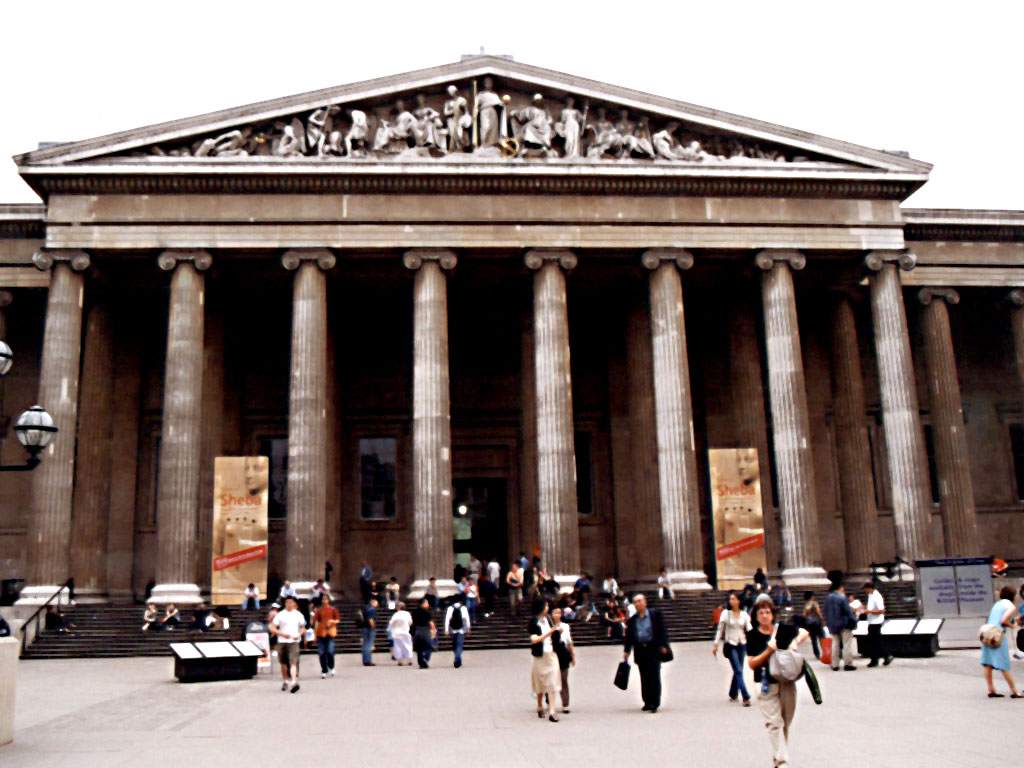 here
are about 2,000 museums and galleries in Britain which include the
chief national collections, and a great variety of independently
or privately owned institutions. But some of the most comprehensive
collections of objects of artistic, archaeological, scientific,
historical and general interest are contained in the national museums
and galleries in London. Among them are the British Museum, the
Victoria and Albert Museum, the Science Museum, the National Gallery,
the Tate Gallery, the National Portrait Gallery, the Geological
Museum, the Natural History Museum, Madame Tussaud's, the Tower of
London and many other treasure institutions. There are national
museums and art galleries in Scotland, Wales and Northern Ireland. In
Edinburgh — the National Museum of Antiquities of Scotland, the
Royal Scottish Museum; in Cardiff — the National Museum of Wales;
in Belfast — the Ulster Museum.
here
are about 2,000 museums and galleries in Britain which include the
chief national collections, and a great variety of independently
or privately owned institutions. But some of the most comprehensive
collections of objects of artistic, archaeological, scientific,
historical and general interest are contained in the national museums
and galleries in London. Among them are the British Museum, the
Victoria and Albert Museum, the Science Museum, the National Gallery,
the Tate Gallery, the National Portrait Gallery, the Geological
Museum, the Natural History Museum, Madame Tussaud's, the Tower of
London and many other treasure institutions. There are national
museums and art galleries in Scotland, Wales and Northern Ireland. In
Edinburgh — the National Museum of Antiquities of Scotland, the
Royal Scottish Museum; in Cardiff — the National Museum of Wales;
in Belfast — the Ulster Museum.
Situated in Bloomsbury, THE BRITISH MUSEUM is the world's largest museum. It was built between 1823 and 1852.Most famous exhibits include the Rosetta Stone in the Southern Egyptian Gallery, and in the manuscript room, the Magna Charta, Nelson's log-book, and Scott's last diary.
T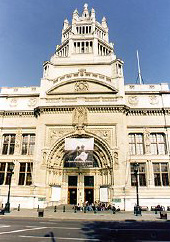 he
British Museum includes also the British Library, which is the
national library of the United Kingdom and ranks among the greatest
libraries in the world, such as the National Library of Congress in
Washington or the National Library in Paris. The Library has the
world-famous collections of about 12 million items of monographs,
manuscripts, maps, stamps, newspapers and sound records. Publishers
are obliged, by law, to supply the Library with a copy of each new
book, pamphlet or newspaper published in Britain.
he
British Museum includes also the British Library, which is the
national library of the United Kingdom and ranks among the greatest
libraries in the world, such as the National Library of Congress in
Washington or the National Library in Paris. The Library has the
world-famous collections of about 12 million items of monographs,
manuscripts, maps, stamps, newspapers and sound records. Publishers
are obliged, by law, to supply the Library with a copy of each new
book, pamphlet or newspaper published in Britain.
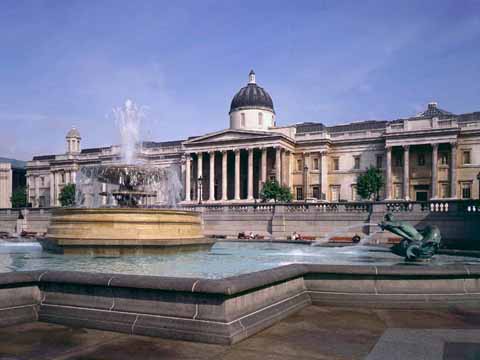 THE
VICTORIA AND ALBERT MUSEUM is a national collection of fine and
applied arts of all countries and periods. Of great interest are the
costumes displays, the rooms of different historical periods, the
jewellery and porcelain, the celebrated Raphael cartoons belonging to
the Crown and the best collection of English miniatures to be found
in the country. The Museum has about seven miles of galleries with
various exhibits, including ethnic arts and crafts.
THE
VICTORIA AND ALBERT MUSEUM is a national collection of fine and
applied arts of all countries and periods. Of great interest are the
costumes displays, the rooms of different historical periods, the
jewellery and porcelain, the celebrated Raphael cartoons belonging to
the Crown and the best collection of English miniatures to be found
in the country. The Museum has about seven miles of galleries with
various exhibits, including ethnic arts and crafts.
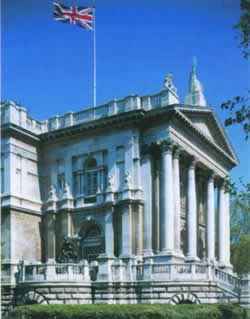 THE
NATIONAL GALLERY exhibits all schools of European painting from the
13th century and includes works by Van Dyck, Rubens, Vermeer,
Holbein, El Greco, Goya, Velasquez, Gainsborough and Leonardo da
Vinci. It also includes the largest collection of Rembrandts outside
Holland. There are over thirty rooms in the Gallery and lectures are
given regularly by experts.
THE
NATIONAL GALLERY exhibits all schools of European painting from the
13th century and includes works by Van Dyck, Rubens, Vermeer,
Holbein, El Greco, Goya, Velasquez, Gainsborough and Leonardo da
Vinci. It also includes the largest collection of Rembrandts outside
Holland. There are over thirty rooms in the Gallery and lectures are
given regularly by experts.
THE TATE GALLERY is really three galleries: a national gallery of British art, a gallery of modern sculpture and a gallery of modern foreign painting. Among the treasures to be found are modern sculptures by Rodin, Moore and Epstein.
T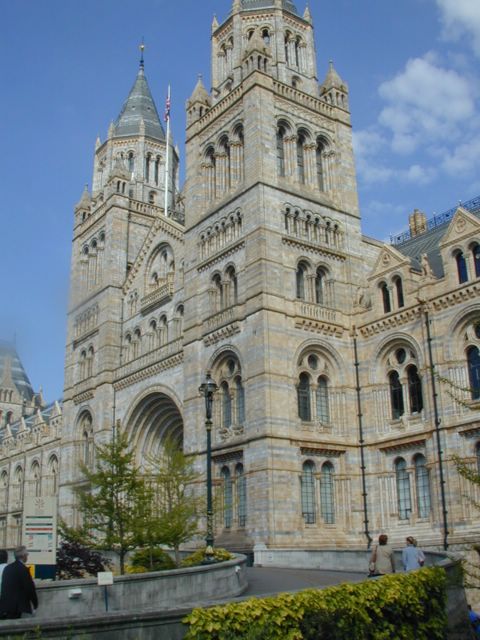 HE
SCIENCE MUSEUM houses the national collections of science, industry
and medicine. Many exhibits are full size and there are many historic
objects of scientific and technological significance. Additionally
there are exhibits sectioned to show their internal construction and
working models. The children's gallery gives a dioramic history of
the development of transport.
HE
SCIENCE MUSEUM houses the national collections of science, industry
and medicine. Many exhibits are full size and there are many historic
objects of scientific and technological significance. Additionally
there are exhibits sectioned to show their internal construction and
working models. The children's gallery gives a dioramic history of
the development of transport.
THE NATURAL HISTORY MUSEUM is the home of the national collections of living and fossil plants and animals. It also has collections of rocks, minerals and meteorites, as well as coins, manuscripts and other treasures. At first these collections were all kept in the British Museum as part of its exhibits. But, over the years, so much was added to the collections that shortage of space became a major problem and, in 1860, it was decided to split off the natural history departments and house them separately. The architect Alfred Waterhouse designed a suitable building, the construction of which was completed in 1880.
The building of the National History Museum, which is over one hundred years old, also houses a scientific research institution. More than 300 scientists are engaged in the identification and classification of animals plants and minerals.
THE NATIONAL ARMY MUSEUM covers the history of the British Army from the formation of the Yeomen of the Guard by Henry VII in 1485 to the outbreak of the First World War in 1914.It also displays the history of the Commonwealth armies up to independence. The Museum is situated in Royal Hospital Road.
T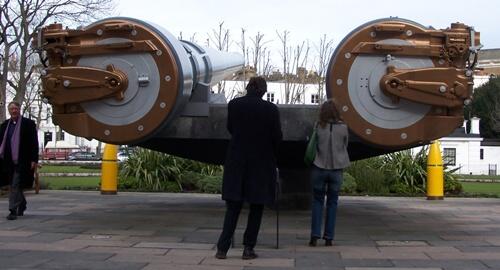 HE
IMPERIAL WAR MUSEUM gives a visual record of all the campaigns in
which
British
and Commonwealth armed forces have been engaged since the outbreak of
the First World War. Its portraits, books, photographs, maps and
films constitute an important source of reference for historians.
HE
IMPERIAL WAR MUSEUM gives a visual record of all the campaigns in
which
British
and Commonwealth armed forces have been engaged since the outbreak of
the First World War. Its portraits, books, photographs, maps and
films constitute an important source of reference for historians.
MADAME TUSSAUD'S MUSEUM OF WAXWORKS in Marylebone Road is one of London's great attractions.
Madame Tussaud first became associated with life-size wax portraits in 1770 when, at the age of 9, she helped her uncle open an exhibition in Paris. When she was 17 she made a wax portrait of Voltaire and followed this with death-masks of Marie Antoinette, Robespierre and other victims of the French Revolution.
She came to England in 1802, travelling with her exhibition for about thirty years before settling down permanently in Baker Street. The exhibition moved to its present site and the Museum was founded in 1884 not far from this street, which is famous as the home of the first great detective in fiction, Conan Doyle's Sherlock Holmes, who shared rooms with Dr.Watson at "22IB", Baker Street. Madame Tussaud continued to make wax models until she was 81.
Her figures were extremely realistic, and their costumes could be characterized by great accuracy. The range of her works was really enormous. A visitor to London's great Wax Museum will see kings and queens, statesmen and writers, actors and musicians, artists and sportsmen, scientists, astronauts, world leaders and so on and so forth. Unsuspecting visitors will be struck by the Chamber of Horrors displaying many notorious criminals.
T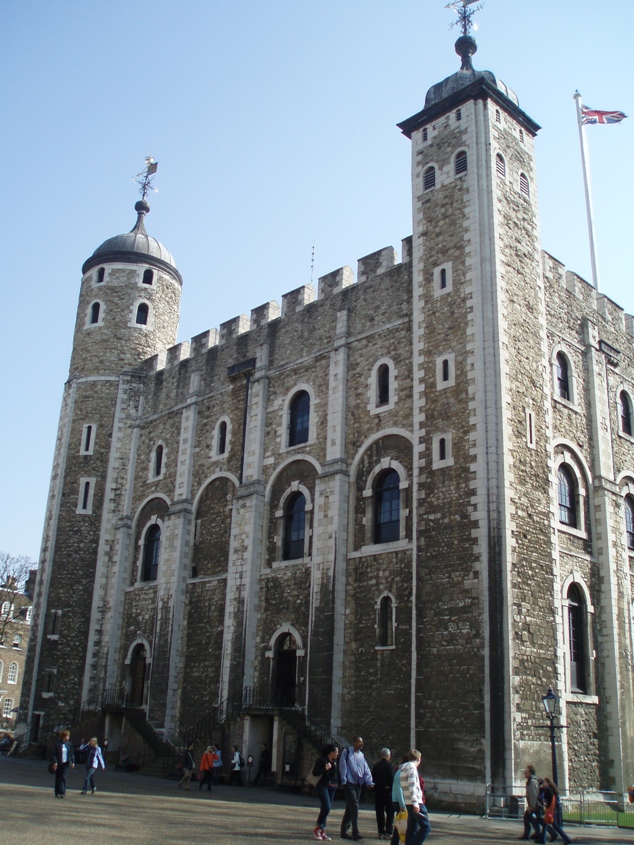 he
last of notable events on view includes those depicting the
historical Battle of Trafalgar and the Battle of Britain.
he
last of notable events on view includes those depicting the
historical Battle of Trafalgar and the Battle of Britain.
THE TOWER OF LONDON is the capital's top tourist attraction. Built to impress and dominate the people of London, it has been a severe symbol of power throughout its 900-year history.
The Tower of London was founded by William the Conqueror in 1066 on the north bank of the Thames, from which he could govern and control the capital of his new kingdom. Successive kings added to the fortification and further building went on until the 19th century.
For centuries the Tower was Britain's most imposing and important centre for historical activity and royal intrigues. In its long history the Tower has been a fortress, a royal residence, a state prison and the Royal Mint. Here can be seen Tower Green, the site, where two of Henry VIII's queens Anne Boleyn and Catherine Howard, met their deaths, the Bloody Tower where "Little Princes", Edward V and his brother, the Duke of York, were murdered in 1483, and where Sir Walter Releigh spent some 13 years writing his "History of the World". Famous prisoners, who were executed in the Tower, include the Earl of Essex, the Duke of Monmouth, Lady Jane Grey and Guy Fawkes, who planned to blow up the Houses of Parliament. Statesmen, bishops, poets, plotters have all met their end in the Tower. Even in the 20th century traitors have died here, several spies were shot during the World Wars.
V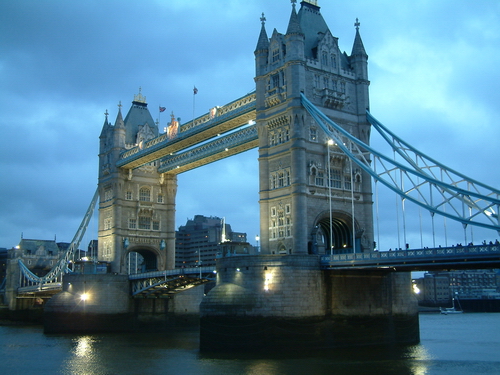 isitors
today can view the instruments of execution and torture, an arsenal
of weapons, and the nation's treasure, the Grown Jewels, dating
mostly from the Restoration (1660).
isitors
today can view the instruments of execution and torture, an arsenal
of weapons, and the nation's treasure, the Grown Jewels, dating
mostly from the Restoration (1660).
TOWER BRIDGE — the gateway to London — was built in 1894.It is the most famous and distinctive bridge in London with two Gothic towers that rise from the riverbed.
Most cities and towns have museums and other treasures devoted to arts, archaeology and natural history. Rich in museums, for example, are Oxford and Cambridge. Many of them are associated with the universities, such as the Ashmolean Museum in Oxford, founded in 1683 and the oldest in the world, and the Fitzwilliam Museum in Cambridge. In York, founded in 1882, is the Yorkshire Museum, containing a wealth of Roman remains and medieval sculpture not to mention a fine natural history collection. The four museums of Norwich cover a wide range of subjects illustrating the background and history of East Anglia.
Many private art collections in historic family mansions, including those owned by the National Trust, are open to the public. An increasing number of open-air museums depict the regional life of an area.
Comprehension Check
